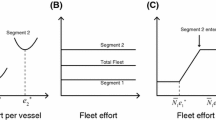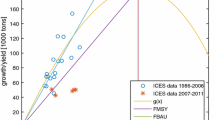Abstract
We develop a bioeconomic model of the northern Balticsalmon fishery that takes into account thesimultaneous harvest of wild and reared salmon. Weassess the optimal harvest allocation between thecommercial offshore, inshore, and estuary fisheries,and the recreational river fishery that sequentiallyharvest the salmon stock. We restrict the solution tospawning stocks sufficient to preserve the wildsalmon. Empirical results suggest closure of theoffshore and inshore fisheries. Optimal managementenhances the wild stock, and results in substantialeconomic gains to the fishery. Current fisheryregulation improves the performance of the fisheryover open access, but fails to utilize the fullproductive potential of the resource.
Similar content being viewed by others
REFERENCES
Bishop, R. C. and K. C. Samples (1980), ‘Sport and Commercial Fisheries Conflicts: ATheoretical Analysis’, J. Environ. Econom. Manage. 7, 220–233.
Canon, M. D., C. D. Cullum and E. Polak (1970), Theory of Optimal Control and Mathematical Programming, New York: McGraw-Hill.
Charles, A. T. and W. J. Reed (1985), “A Bioeconomic Analysis of Sequential Fisheries: Competition,Coexistence, and Optimal Harvest Allocation between Inshore and Offshore Fleets”, Canad. J. Fisheries Aquatic Sci. 42, 952–962.
Clark, C. W. (1990), Mathematical Bioeconomics, 2nd edition, NewYork: Wiley.
Clark, C. W. and G. P. Kirkwood (1979), ‘Bioeconomic Model of the Gulf of CarpentariaPrawn Fishery’, J. Fisheries Res. Board Canad. 36, 1304–1312.
Finnish Game and Fisheries ResearchInstitute (FGGRI) (1993), Itämeren lohi ja lohen kalastus, (The Baltic Salmon and the Salmon Fishery), Helsinki.
Finnish Game and Fisheries Research Institute (FGGRI) (1994), ‘Prices Paid to Fishermen in 1993’,Official Statistics of Finland, 1994, 5.
Gordon, S. H., ‘The Economic Theory of a Common PropertyResource: The Fishery’, J. Polit. Econom. 62, 124–142.
Hannesson, R., ‘Sequential Fishing:Cooperative and Noncooperative Equilibria’, Nat. Res. Mod. 9, 51–59.
International Council for theExploration of the Sea (ICES) (1992), Report of the Baltic Salmon and Trout Assessment Group, ICES CM 1992/Assess: 13.
International Council for the Exploration of the Sea (ICES) (1993), Report of theBaltic Salmon and Trout Assessment Group, ICES CM 1993/Assess: 14.
International Council for theExploration of the Sea (ICES) (1994), Report of the Baltic Salmon and Trout Assessment Group, ICES CM 1994/Assess: 15.
International Council for the Exploration of the Sea (ICES) (1995), Report of theBaltic Salmon and Trout Assessment Group, ICES CM 1995/Assess: 16, Ref. M.
International Councilfor the Exploration of the Sea (ICES) (1996), Report of the Baltic Salmon and Trout Assessment Group, ICES CM 1996/Assess: 17.
Lipton, D.W. and I. E. Strand, Jr. (1989), ‘The Effect of Common Propertyon the Optimal Structure of the Fishing Industry’, J. Environ. Econom. Manage. 16, 45–51.
McConnell, K. E. and J. G. Sutinen (1979), ‘Bioeconomic Models of Marine Recreational Fishing’, J.Environ. Econom. Manage. 6, 127–139.
McKelvey, R. (1983), ‘The Fishery in a FluctuatingEnvironment: Coexistence of Specialist and Generalist Fishing Vessels in a Multipurpose Fleet’, J. Environ. Econom. Manage. 10, 287–309.
McKelvey, R. (1997), ‘Game-Theoretic Insight into the InternationalManagement of Fisheries’, Nat. Res. Mod. 10, 129–171.
Mickwitz, P. (1994), Why is the SalmonPrice in Finland so “Low” — Analyses of the Demand for Salmon in Finland. Mimeo. Finnish Game and Fisheries Research Institute, Helsinki.
Author information
Authors and Affiliations
Rights and permissions
About this article
Cite this article
Laukkanen, M. A Bioeconomic Analysis of the Northern Baltic Salmon Fishery: Coexistence versus Exclusion of Competing Sequential Fisheries. Environmental and Resource Economics 18, 293–315 (2001). https://doi.org/10.1023/A:1011164523802
Issue Date:
DOI: https://doi.org/10.1023/A:1011164523802




